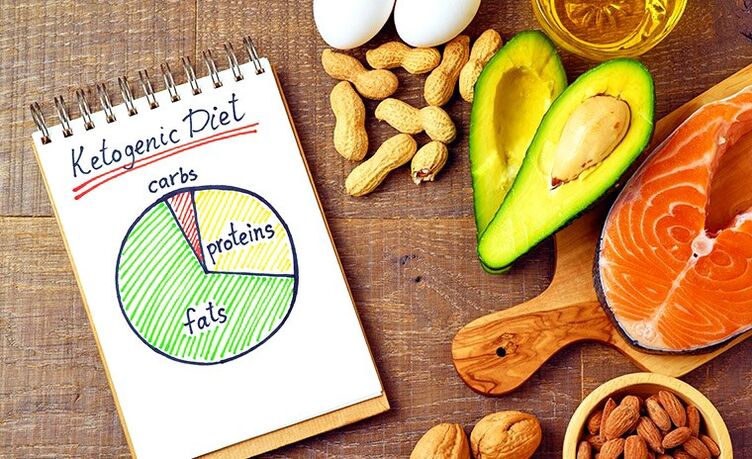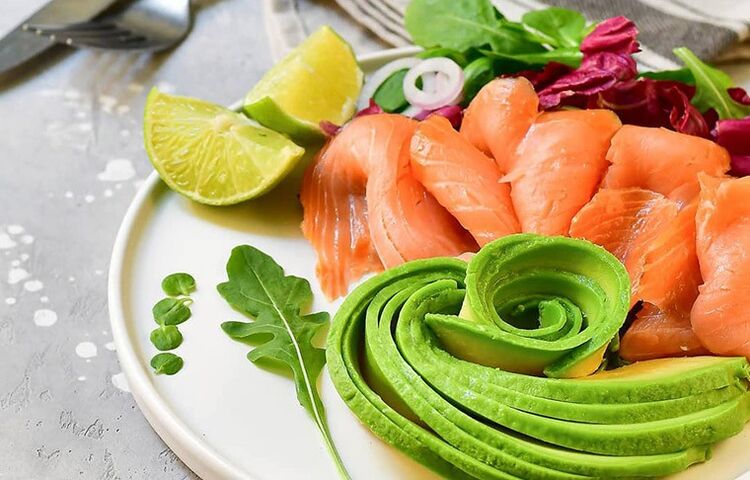
If twenty or thirty years ago, someone sorted all the baskets according to the principle of maximum and minimum utility, and put them in two baskets, then today you need to look at them carefully. An astonishing event took place at this time with oil — the last major enemy of mankind, not only was he completely restored, but he declared himself his Savior. That’s what nutritionist Chris More understands.
Recently, a patient admitted to me and my husband that I ate almost a pound of bacon a week - three pieces for breakfast and then two more meals with a salad for lunch. I’ve been working as a nutritionist for over twenty years, but nothing seems to surprise me, but I still can’t stand it: why? The patient said that her husband had seen a TV show about the keto diet, and they decided to try it. After six months of drinking bacon, her husband lost nine pounds [9 kg] and, according to his wife, almost regained his strength.
Increasingly, I hear from people about the wonders of the keto diet. They say that it burns fat, gives strength and overcomes pain, and you can no longer eat as much bacon as you want. But all their enthusiasm requires at least a serious test - is a keto diet that doesn’t limit animal fat intake really good?
A ketogenic diet is a low-carbohydrate diet that is low in fat and moderate in protein. Initially, ketones were used to treat epilepsy in children by raising blood levels.
What is ketosis?
Let's start with the name of the diet: where did this "keto" come from? When the body is deficient in carbohydrates, such as after diabetes or prolonged starvation, it needs to break down its fat more actively than usual to gain energy. Ketosis develops: Metabolism is disrupted and ketones accumulate in the tissues more than the body needs. Ketone bodies are products of fat metabolism. They are produced by the liver when the level of insulin in the blood decreases.
"The liver makes ketones all the time, but its levels depend on the carbohydrates and proteins you eat - both the body needs, " explains Jeff Wolek, a professor at Ohio University.
In a healthy person, the breakdown of fat and the formation of the ketone body is a normal process called ketogenesis. Unlike ketosis, ketogenesis does not lead to weight loss. Ketosis is a pathology caused by the keto diet, in addition to diabetes and prolonged fasting, because it eliminates carbohydrate foods from the diet. A person who develops ketosis loses weight, as well as due to some other pathologies.
A ketogenic diet forces the body to use fat as its main source of energy. This role is usually played by carbohydrates, which are converted into glucose along with food and are essential for the brain's nutrition and function. However, when the diet is low in carbohydrates, the liver converts fats into acids and ketone bodies. Ketone bodies enter the brain and are used as a source of energy instead of glucose. Elevated levels of ketone bodies in the blood (ketosis) lead to a decrease in the seizure system.
The main part of the daily diet in the keto diet - from 60 to 80% - fats, proteins - about 15%, the remaining 10% are only carbohydrates (this is half of a small bun). At first glance, it is similar to the Atkins diet, but the keto diet contains more carbohydrate restriction, said Spencer Nadolsky, author of the May Loss Recipe. Some theorists claim that the less carbohydrates you eat, the more fat your body burns, and as a result, your metabolism improves and your immunity increases - and in general, your body begins to experience various miracles.
However, in normal life we get about half of the calories and one tenth of the carbohydrates. So, in fact, the question arises: is it possible for your body to be in ketosis in order to achieve the promised nirvana without serious health consequences? Do you literally start out with fat?
Is the keto diet right for you?
This may sound strange, but the best diet for you is the one you are used to. It's good for Volek, who has been with keto for twenty years, but does it suit you? Unfortunately, there is no research on what happens to a person who has been on a keto diet for a long time. In the A to Z weight loss study, researchers studied the Atkins diet, Zone, LEARN and other diets, but in the study, women consumed 25-35% of carbohydrates - less than 10%. Limit yourself to a keto diet.
One thing is certain: on a keto diet you will lose weight. In Italy in 2015, they studied the work of people sitting there and lost an average of 10-12 kilograms in three months. A year ago in Spain it was possible to lose about 20 kilograms in one year. Indeed, after following a strict diet the following year, the subjects returned to pre-experimental weight.
If you decide to try it, what will you eat? First and second, that bacon. Of the other products, most are not. Starchy vegetables - potatoes, pumpkins, corn - like most fruits, are strictly forbidden. You also have to forget about milk, beans, rice and pasta.
Keeping a keto diet is difficult and dangerous for some. "Excessive diets, especially the keto diet, are completely contraindicated in people with neurodegenerative diseases such as epilepsy, " says Dr. Alan Aragon.
Ketogenic diet is considered optimal for weight loss in society. However, according to scientific evidence, the effect of weight loss soon after switching to a ketogenic diet is due to a decrease in body water, and only the energy balance affects the amount of fat in the body. To lose weight, the energy provided by food should be less than the cost of physical activity. One of the benefits of a ketogenic diet, like other low-carbohydrate diets, is that ketosis, caused by low-carbohydrate diets, promotes weight loss in obesity. The difference in calories eaten from a low-fat diet can be up to a thousand kilocalories per day. The effects of ketogenic diets are highly dependent on the protein content of the diet.
Can I take drugs that increase ketone levels? In no case. Even if you are not on a diet, do not listen to "consultants" who claim that you can get ketosis with the help of special drugs.
So, is the keto diet right for you or not? If you are an extreme athlete who is ready to experiment with your body, if you like to take risks and fast results are important to you, then check it out! If you just want to lose a few pounds and have already experienced the "yo-yo effect" (when a person breaks down after a strict diet and gains more weight than they lose weight), then you don’t need to take the risk. However, if you approach the keto diet wisely, you can learn three lessons from it, which will definitely be useful.
- Reduce "empty" carbohydrates. Examine your daily carbohydrate intake: If it comes from fruits rich in fiber and antioxidants, nothing will happen, but if the source of carbohydrates is candy, soda and white flour. What to do: You can send them to the trash.
- Stay away from obesity. The craving for low-fat foods began in the 1990's and is still very much alive. There is nothing good here. In many cases, manufacturers increase the amount of sugar in such products to make up for the lack of fat. Eat fatty fish such as salmon, mackerel or sardines at least twice a week. No matter what you cook, don't give up fruits and vegetables, especially olive oil.
- Eat lots of green grass. All leafy vegetables and greens are combined with fatty and protein foods - fans of the keto diet eat them a lot. You will do the same. Eat kale, spinach, green tea, arugula and other salads without restrictions.
What happened to my bacon patients? Their nutritional experience continued until their children were born. Of course, they immediately forgot about the diet (as the young mother explained, there is no time to think about it). So remember: sooner or later you will get tired of filling yourself with bacon and return to the usual familiar food.
Recipes

Salmon and asparagus salad
Ingredients:
- 150 g of salmon fillets;
- 80 g of green asparagus;
- 1/2 head iceberg lettuce;
- 2 eggs;
- 4 fillets of anchovies;
- 5 cherry tomatoes;
- 5 large capers (or 6-8 small ones) - put capers in salt, not salt, they should be washed before use;
- 1/2 medium red onion;
- 6-8 Art. l. olive oil;
- 1 teaspoon mustard;
- juice of half a lemon.
How to cook:
- If you have already cooked nicotine, you can also work with this salad. It repeats the main course of Nice, only fat salmon is used instead of tuna, and asparagus is used instead of green beans (but you can also use beans).
- It is better to cook salmon in a steamer or in a slow cooker, rather than in a hot pan or hot oven: 20-30 minutes at a temperature of 80-85 degrees, not higher (otherwise the protein will wrinkle and the fish will be hard). You can also fry it in a pan (don't overdo it! ) - the fish should be tender and transparent inside.
- Cook asparagus. It needs to be sharp, so don’t overcook it! The cooking time depends on its size, so we do not recommend leaving the oven - asparagus cooks quickly.
- Place the spread iceberg on a plate (salad should be washed, dried and cut into medium pieces), asparagus, salmon, cut into large pieces, half a cherry tomato, anchovies, capers, onion rings and boiled eggs (preferably liquid, but soft yolk)should not remain). The surface of the fields mixed with olive oil sauce with Dijon mustard and lemon juice. There is no need to salt the dish - anchovies and capers are already salty enough.
The ketogenic diet is used by athletes who practice endurance sports, such as ultramarathon, triathlon, cycling and others. Athletes on this diet use fats efficiently as a source of energy and thus help maintain glycogen stores. long-lasting force.
Bacon and lettuce salad
Ingredients:
- 2 salad heads in the palm of your hand
- 100 g of bacon;
- 8 branches of mint;
- 1 egg yolk;
- 6 tablespoons. l. for frying in olive oil and a little more;
- 1 teaspoon granular mustard;
- 1 tbsp. l. sherry vinegar.
How to cook:
- For this salad, you need to make a slightly more complex sauce: put mint leaves and mustard in a tall glass, add egg yolks and pour sherry vinegar. Beat in a blender while adding the olive oil to the thin stream.
- Cut the lettuce in half lengthwise and fry over low heat. It should be slightly caramelized, that is, it will have a golden brown color and the inside will remain clean and crispy. Fry the bacon over a high heat until it is fat-free or crispy in the oven. Put salad, bacon and sauce on a plate. Garnish with mint leaves.














































































